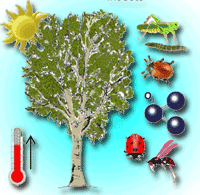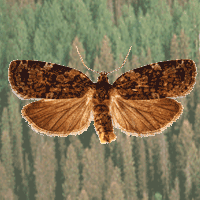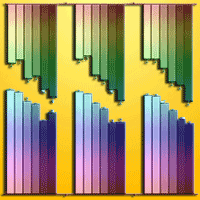Current knowledge on the ecological impact of the emission of volatile isoprenoids by plants is reviewed. This trait is common to many terrestrial species but is scattered across different taxonomic groups; it appears to be related to other ecological traits rather than to phylogenetic relationships. Plants invest high resources to produce volatile isoprenoids, which are likely to play multiple roles in the defence against biotic and abiotic stressors. We describe how constitutive and induced volatile isoprenoids may directly or indirectly defend plants, and briefly address how indirect defence may involve communication with other trophic levels beyond the simple plant-herbivory interaction. It is discussed that, as metabolically costly defensive mechanisms are only activated after attacks, induced volatile isoprenoids may also prime other biochemical pathways that are involved in stress resistance responses. It is also surmised that attacked plants may also use volatiles as an airborne communication to signal the attack to other leaves or other plant organs, or even other plants, eliciting defence responses.
Keywords
, , , ,
Citation
Fineschi S, Loreto F (2012). Leaf volatile isoprenoids: an important defensive armament in forest tree species. iForest 5: 13-17. - doi: 10.3832/ifor0607-009
Academic Editor
Gabriele Bucci
Paper history
Received: Nov 30, 2011
Accepted: Feb 07, 2012
First online: Feb 14, 2012
Publication Date: Feb 27, 2012
Publication Time: 0.23 months
© SISEF - The Italian Society of Silviculture and Forest Ecology 2012
Open Access
This article is distributed under the terms of the Creative Commons Attribution-Non Commercial 4.0 International (https://creativecommons.org/licenses/by-nc/4.0/), which permits unrestricted use, distribution, and reproduction in any medium, provided you give appropriate credit to the original author(s) and the source, provide a link to the Creative Commons license, and indicate if changes were made.

Breakdown by View Type
(Waiting for server response...)
Article Usage
Total Article Views: 68863
(from publication date up to now)
Breakdown by View Type
HTML Page Views: 57050
Abstract Page Views: 3716
PDF Downloads: 6270
Citation/Reference Downloads: 66
XML Downloads: 1761
Web Metrics
Days since publication: 5056
Overall contacts: 68863
Avg. contacts per week: 95.34
Article Citations
Article citations are based on data periodically collected from the Clarivate Web of Science web site
(last update: Mar 2025)
Total number of cites (since 2012): 29
Average cites per year: 2.07
Publication Metrics
by Dimensions ©
Articles citing this article
List of the papers citing this article based on CrossRef Cited-by.
(1)
Affek HP, Yakir D (2002)Protection by isoprene against singlet oxygen in leaves. Plant Physiology 129: 269-277.
CrossRef |
Gscholar
(2)
Baldwin IT, Halitschke R, Paschold A, von Dahl CC, Preston CA (2006)Volatile signaling in plant-plant interactions: “Talking Trees” in the genomics era. Science 311: 812-815.
CrossRef |
Gscholar
(3)
Behnke K, Grote R, Brueggemann N, Zimmer I, Zhou G, Elobeid M, Janz D, Polle A, Schnitzler J-P (2011)Isoprene emission-free poplars - a chance to reduce the impact from poplar plantations on the atmosphere. New Phytologist (early view).
CrossRef |
Gscholar
(4)
Blande JD, Holopainen JK, Li T (2010)Air pollution impedes plant-to-plant communication by volatiles. Ecology Letters 13: 1172-1181.
CrossRef |
Gscholar
(5)
Brilli F, Barta C, Fortunati A, Lerdau M, Loreto F, Centritto M (2007)Response of isoprene emission and carbon metabolism to drought in white poplar (
Populus alba) saplings. New Phytologist 175: 244-254.
CrossRef |
Gscholar
(6)
Bronstein JL, Alarcón R, Geber M (2006)The evolution of plant-insect mutualisms. New Phytologist 172: 412-428.
CrossRef |
Gscholar
(7)
Demming-Adams B, Adams WW (2002)Antioxidants in photosynthesis and human nutrition. Science 298: 2149-2153.
CrossRef |
Gscholar
(8)
Dicke M, Baldwin IT (2010)The evolutionary context for herbivore-induced plant volatiles: beyond the “cry for help”. Trends in Plant Science 15: 167-175.
CrossRef |
Gscholar
(9)
Dicke M, de Boer JG, Höfte M, Rocha-Granados MC (2003)Mixed blends of herbivore-induced plant volatiles and foraging success of carnivorous arthropods. Oikos 101: 38-48.
CrossRef |
Gscholar
(10)
Fowler D, Pilegaard K, Sutton MA, Ambus P, Raivonen M, Duyzer J, Simpson D, Fagerli H, Fuzzi S, Schjoerring JK, Granier C, Neftel A, Isaksen ISA, Laj P, Maione M, Monks PS, Burkhardt J, Daemmgen U, Neirynck J, Personne E, Wichink-Kruit R, Butterbach-Bahl K, Flechard C, Tuovinen JP, Coyle M, Gerosa G, Loubet B, Altimir N, Gruenhage L, Ammann C, Cieslik S, Paoletti E, Mikkelsen TN, Ro-Poulsen H, Cellier P, Cape JN, Horvath L, Loreto F, Niinemets U, Palmer PI, Rinne J, Misztal P, Nemitz E, Nilsson D, Pryor S, Gallagher MW, Vesala T, Skiba U, Bruggemann N, Zechmeister-Boltenstern S, Williams J, O’Dowd C, Facchini MC, de Leeuw G, Flossman A, Chaumerliac N, Erisman JW (2009)Atmospheric composition change: ecosystems-atmosphere interactions. Atmospheric Environment 43: 5193-5267.
CrossRef |
Gscholar
(11)
Frost CJ, Appel HM, Carlson JE, De Moraes CM, Mescher MC, Schultz JC (2007)Within-plant signalling via volatiles overcomes vascular constraints on systemic signalling and primes responses against herbivores. Ecology Letters 10: 490-498.
CrossRef |
Gscholar
(12)
Frost CJ, Mescher MC, Carlson JE, De Moraes CM (2008)Plant defense priming against herbivores: getting ready for a different battle. Plant physiology 146: 818-824.
CrossRef |
Gscholar
(13)
Hanover JW (1992)Applications of terpene analysis in forest genetics. New Forests 6: 159-178.
CrossRef |
Gscholar
(14)
Hanson DT, Swanson S, Graham L E, Sharkey TD (1999)Evolutionary significance of isoprene emission from mosses. American Journal of Botany 86: 634-639.
CrossRef |
Gscholar
(15)
Harley PC, Monson RK, Lerdau MT (1999)Ecological and evolutionary aspects of isoprene emission from plants. Oecologia 118: 109-123.
CrossRef |
Gscholar
(16)
Heil M, Ton J (2010)Systemic resistance induction by vascular and airborne signalling. Progress in Botany 71: 279-306.
CrossRef |
Gscholar
(17)
Heil M (2008)Indirect defence via tritrophic interactions. New Phytologist 178: 41-61.
CrossRef |
Gscholar
(18)
Holopainen JK, Heijari J, Nerg AM, Vuorinen M, Kainulainen P (2009)Potential for the use of exogenous chemical elicitors in disease and insect pest management of conifer seedling production. The Open Forest Science Journal 2: 17-24.
CrossRef |
Gscholar
(19)
Kesselmeier J, Staudt M (1999)Biogenic volatile organic compounds (VOC): an overview on emission, physiology and ecology. Journal of Atmospheric Chemistry 33: 23-88.
CrossRef |
Gscholar
(20)
Kesselmeier J, Ciccioli P, Kuhn U, Stefani P, Biesenthal T, Rottenberger S, Wolf A, Vitullo M, Valentini R, Nobre A, Kabat P, Andreae MO (2002)Volatile organic compound emissions in relation to plant carbon fixation and the terrestrial carbon budget. Global Biogeochemical Cycles 6: 1126.
CrossRef |
Gscholar
(21)
Knudsen JT, Tollsten L, Bergstorm LG (1993)Floral scents: a checklist of volatile compounds isolated by head-space techniques. Phytochemistry 33: 253-280.
CrossRef |
Gscholar
(22)
Lerdau M, Gray D (2003)Ecology and evolution of light-dependent and light-independent phytogenic volatile organic carbon. New Phytologist 157: 199-211.
CrossRef |
Gscholar
(23)
Lichtenthaler HK, Schwender J, Disch A, Rohmer M (1997)Biosynthesis of isoprenoids in higher plant chloroplasts proceeds via a mevalonate-independent pathway. FEBS Letters 400: 271-274.
CrossRef |
Gscholar
(24)
Loreto F, Schnitzler JP (2010)Abiotic stresses and induced BVOCs. Trends in Plant Science 15: 154-166.
CrossRef |
Gscholar
(25)
Loreto F, Velikova V (2001)Isoprene produced by leaves protects the photosynthetic apparatus against ozone damage, quenches ozone products, and reduces lipid peroxidation of cellular membranes. Plant Physiology 127: 1781-1787.
CrossRef |
Gscholar
(26)
Loreto F, Ciccioli P, Brancaleoni E, Valentini R, De Lillis M, Csiky O, Seufert G (1998)A hypothesis on the evolution of isoprenoid emission by oaks based on the correlation between emission type and
Quercus taxonomy. Oecologia 115: 302-305.
CrossRef |
Gscholar
(27)
Loreto F, Nascetti P, Graverini A, Mannozzi M (2000)Emission and content of monoterpenes in intact and wounded needles of the Mediterranean Pine,
Pinus pinea. Functional Ecology 14: 589-595.
CrossRef |
Gscholar
(28)
Loreto F, Mannozzi M, Maris C, Nascetti P, Ferranti F, Pasqualini S (2001)Ozone quenching properties of isoprene and its antioxidant role in leaves. Plant Physiology 126: 993-1000.
CrossRef |
Gscholar
(29)
Loreto F, Bagnoli F, Fineschi S (2009)One species, many terpenes: matching chemical and biological diversity. Trends in Plant Science 14: 416-420.
CrossRef |
Gscholar
(30)
Magri D, Fineschi S, Bellarosa R, Buonamici A, Sebastiani F, Schirone B, Simeone MC, Vendramin GG (2007)The distribution of
Quercus suber chloroplast haplotypes matches the palaeogeographical history of the western Mediterranean. Molecular Ecology 16: 5259-5266.
CrossRef |
Gscholar
(31)
Matthes MC, Bruce TJA, Ton J, Verrier PJ, Pickett JA, Napier JA (2010)The transcriptome of cis-jasmone-induced resistance in
Arabidopsis thaliana and its role in indirect defence. Planta 232: 1163-1180.
CrossRef |
Gscholar
(32)
McFrederick QS, Kathilankal JC, Fuentes JD (2008)Air pollution modifies floral scent trails. Atmospheric Environment 42: 2336-2348.
CrossRef |
Gscholar
(33)
Michelozzi M, Tognetti R, Maggino F, Radicati M (2008)Seasonal variations in monoterpene profiles and ecophysiological traits in Mediterranean pine species of group “halepensis”. iForest 1: 65-74.
CrossRef |
Gscholar
(34)
Pasqua G, Monacelli B, Manfredini C, Loreto F, Perez G (2002)The role of isoprenoid accumulation and oxidation in sealing wounded needles of Mediterranean pines. Plant Science 163: 355-359.
CrossRef |
Gscholar
(35)
Sharkey TD, Yeh S, Wiberley AE, Falbel TG, Gong D, Fernandez DE (2005)Evolution of the isoprene biosynthetic pathway in Kudzu. Plant Physiology 137: 700-712.
CrossRef |
Gscholar
(36)
Singsaas EL, Lerdau M, Winter K, Sharkey TD (1997)lsoprene increases thermotolerance of isoprene-emitting species. Plant Physiology 115: 1413-1420.
Online |
Gscholar
(37)
Staudt M, Mir C, Joffre R, Rambal S, Bonin A, Landais D, Lumaret R (2004)Isoprenoid emissions of
Quercus spp. (
Q. suber and
Q. ilex) in mixed stands contrasting in interspecific genetic introgression. New Phytologist 163: 573-584.
CrossRef |
Gscholar
(38)
Steeghs M, Bais HP, de Gouw J, Goldan P, Kuster W, Northway M, Fall R, Vivanco JM (2004)Proton-transfer-reaction mass spectrometry (PTR-MS) as a new tool for real time analysis of root-secreted volatile organic compounds (VOCs) in
Arabidopsis thaliana. Plant Physiology 135: 47-58.
CrossRef |
Gscholar
(39)
Strauss SY, Rudgers JA, Lau JA, Irwin RE (2002)Direct and ecological costs of resistance to herbivory. Trends in Ecology and Evolution 17: 278-285.
CrossRef |
Gscholar
(40)
Tholl D, Sohrabi R, Huh JH, Lee S (2011)The biochemistry of homoterpenes - Common constituents of floral and herbivore-induced plant volatile bouquets. Phytochemistry 72: 1635-1646.
CrossRef |
Gscholar
(41)
Velikova V, Fares S, Loreto F (2008)Isoprene and nitric oxide reduce damages in leaves exposed to oxidative stress. Plant Cell and Environment 31: 1882-1894.
CrossRef |
Gscholar
(42)
Velikova V, Varkonyi Z, Szabo M, Maslenkova L, Nogues I, Kovacs L, Peeva V, Busheva, M, Garab G, Sharkey TD, Loreto F (2011)Increased thermostability of thylakoid membranes in isoprene-emitting leaves probed with three biophysical techniques. Plant Physiology157: 905-916.
CrossRef |
Gscholar
(43)
Velikova V, Sharkey TD, Loreto F (2012)Stabilization of thylakoid membranes in isoprene-emitting plants reduces formation of reactive oxygen species. Plant Signaling and Behaviour 7: 139-141.
CrossRef |
Gscholar
(44)
Vickers CE, Gershenzon J, Lerdau MT, Loreto F (2009)A unified mechanism of action for volatile isoprenoids in plant abiotic stress. Nature Chemical Biology 5: 283-291.
CrossRef |
Gscholar
(45)
Wilson ID, Neill SJ, Hancock JT (2008)Nitric oxide synthesis and signalling in plants. Plant Cell and Environment 31: 622-631.
CrossRef |
Gscholar


















